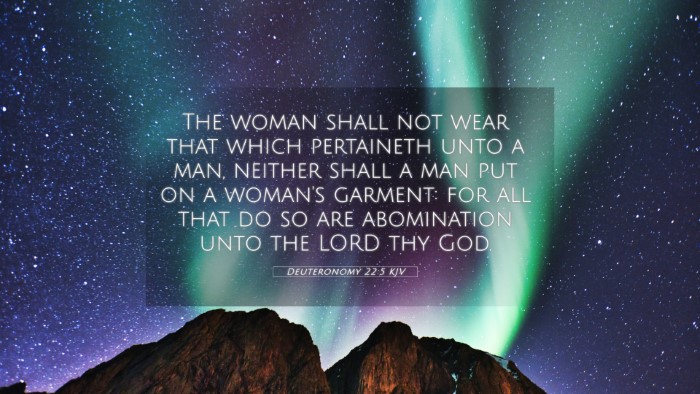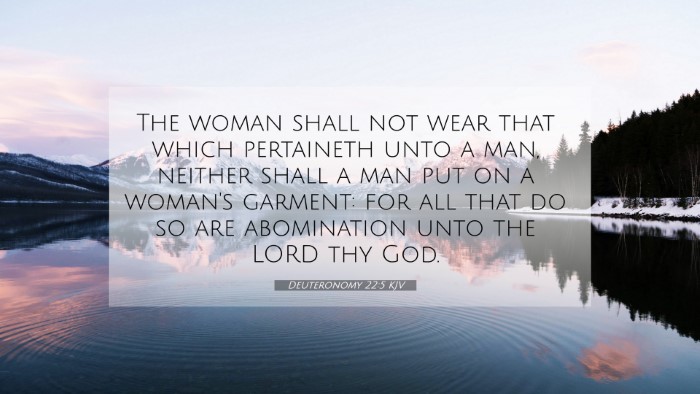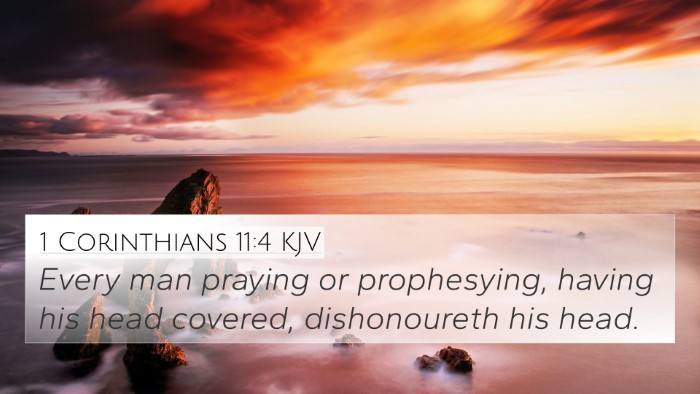Understanding Deuteronomy 22:5
Verse: “The woman shall not wear that which pertaineth unto a man, neither shall a man put on a woman’s garment: for all that do so are abomination unto the Lord thy God.”
Overview
Deuteronomy 22:5 addresses issues of gender distinction in clothing, which reflects broader themes of order and identity established by God in creation. The verse prohibits cross-dressing, indicating a divine order that the Israelites were to uphold. To appreciate its meaning, we can explore connections to other Scripture, shedding light on the intentions behind this command.
Key Themes and Insights
- Gender Distinction: This command underscores the importance of recognizing and honoring God-given gender roles, as highlighted in Matthew Henry's commentary. The difference in attire suggests a deeper principle of maintaining the design that God established in creation.
- Holiness and Separation: Albert Barnes explains that such regulations were part of a broader mandate guiding Israel to be separate from the surrounding nations, emphasizing holiness. The practices of neighboring cultures often blurred gender lines, which an Israelite was to avoid.
- Cultural Context: Adam Clarke points out that this regulation must also be understood in its cultural context, where clothing was tied to one's identity. Therefore, the command serves to reinforce societal norms as designed by God.
Bible Verse Cross-References
Understanding Deuteronomy 22:5 can be enhanced by exploring related verses that delve into themes of gender, identity, and God's laws:
- Genesis 1:27: "So God created man in his own image, in the image of God created he him; male and female created he them."—Establishing the inherent distinction and value of gender created by God.
- 1 Timothy 2:9-10: "In like manner also, that women adorn themselves in modest apparel, with propriety and moderation..."—Encouraging distinction and modesty in dress.
- 1 Corinthians 11:14-15: "Doth not even nature itself teach you, that, if a man have long hair, it is a shame unto him? But if a woman have long hair, it is a glory to her..."—Referencing natural order and its manifestation through appearance.
- Leviticus 18:22: "Thou shalt not lie with mankind, as with womankind: it is abomination."—Further highlighting the contrast between male and female roles as divinely ordained.
- Romans 1:26-27: "For this cause God gave them up unto vile affections: for even their women did change the natural use into that which is against nature..."—Discussing consequences of deviating from God’s design.
- 1 Peter 3:3-4: "Whose adorning let it not be that outward adorning of plaiting the hair, and of wearing of gold, or of putting on of apparel; but let it be the hidden man of the heart..."—Emphasizing the importance of inner beauty over external appearance.
- Deuteronomy 23:17: "There shall be no whore of the daughters of Israel, nor a sodomite of the sons of Israel."—Discussing roles and behaviors expected of gender within the community.
Comparative Bible Verse Analysis
The theological implications of Deuteronomy 22:5 extend beyond mere clothing regulations to encompass a holistic understanding of identity and societal roles that reflect God’s creative order. The discussion also bridges the gap between the Old and New Testaments, revealing consistent themes across the Scriptures.
Connections Between Bible Verses
When studying Deuteronomy 22:5, one recognizes the connections between this verse and those emphasizing the holiness expected from God’s people. For instance, passages that outline moral conduct, prohibitions of certain behaviors, and standards of living form a unified perspective that highlights God's expectations in forming a community reflective of His character.
Cultural Implications and Theological Reflection
The prohibition against cross-dressing, therefore, is not just a cultural artifact but a theological assertion that transcends time. It insists that the distinctions God has ordained should not be blurred. Commentators like Matthew Henry assert that to ignore these distinctions is to challenge God’s authority in the creation process.
Tools for Bible Cross-Referencing
For those studying this verse, employing cross-reference tools can enhance understanding. Utilizing a Bible concordance or a specialized Bible cross-reference guide can provide clarity on linked scriptures and Biblical themes.
Conclusion
In summary, Deuteronomy 22:5 provides invaluable insights into God's design for humanity. By understanding its place within the larger narrative of Scripture, believers can comprehend the enduring principles of gender distinction and societal conduct as intended by the Creator. Through the use of cross-referencing and thematic connections, one can deepen their biblical literacy and appreciate the unity of God's message throughout the ages.




